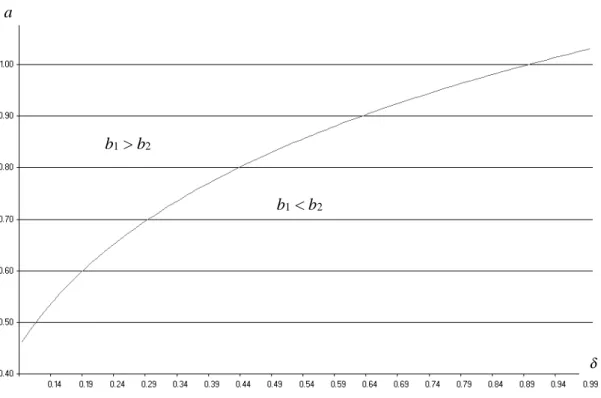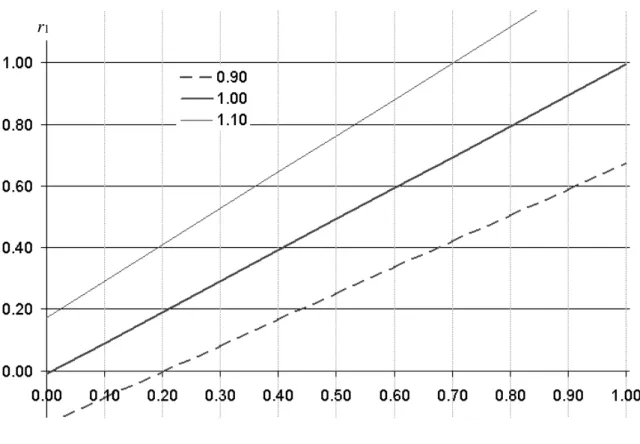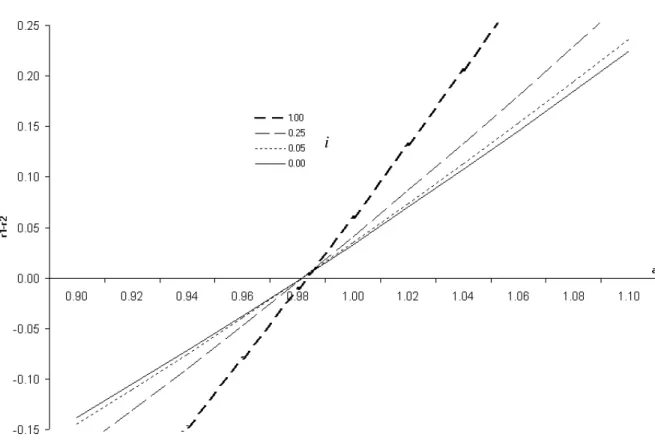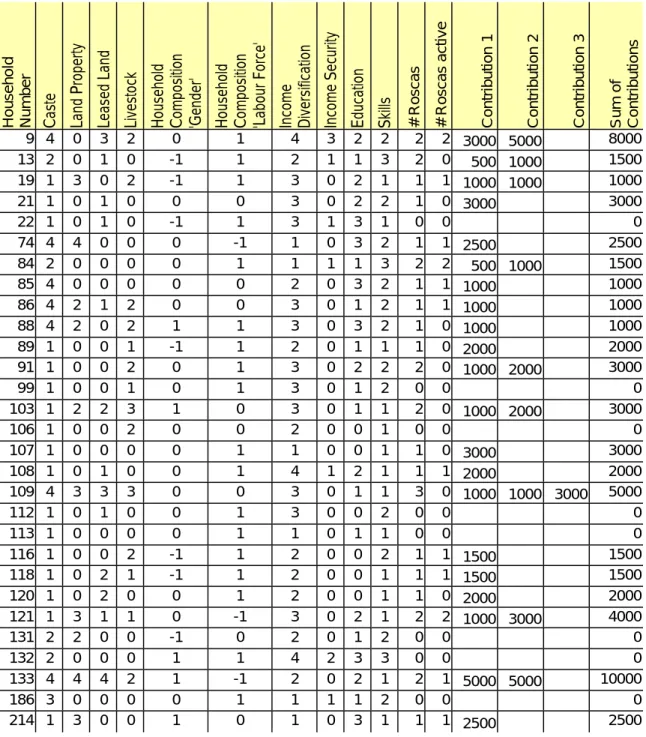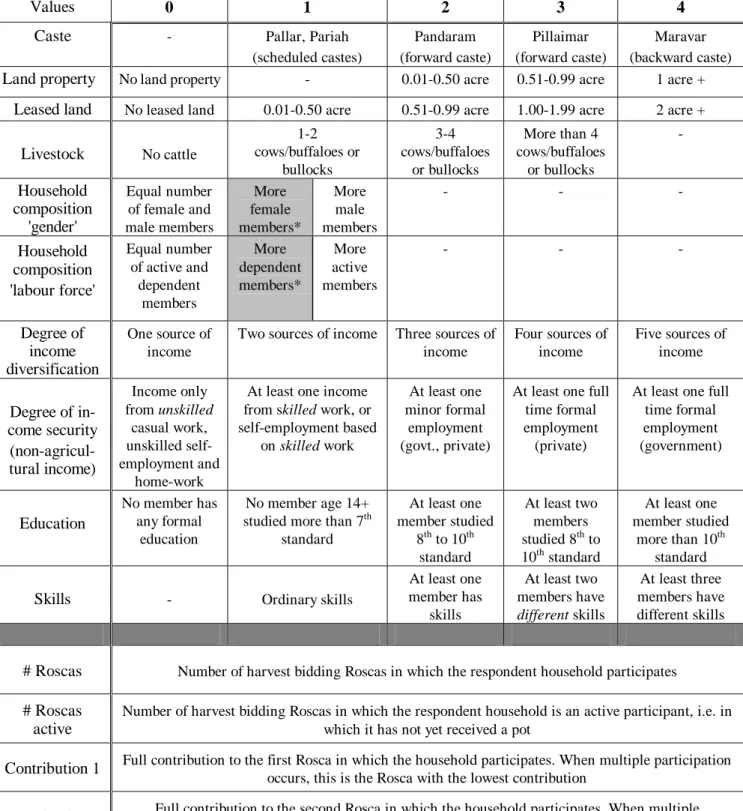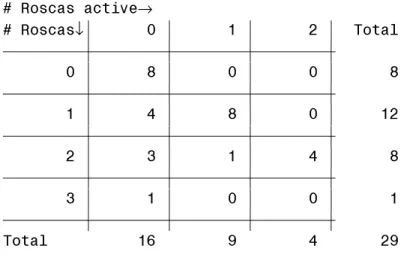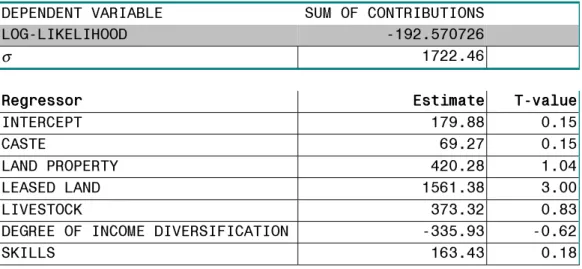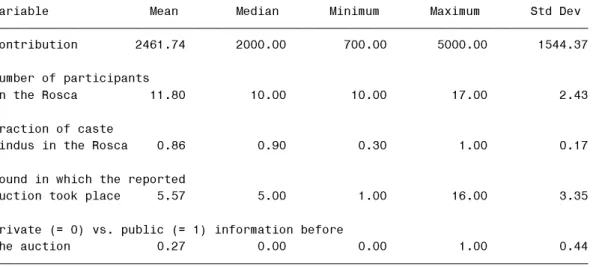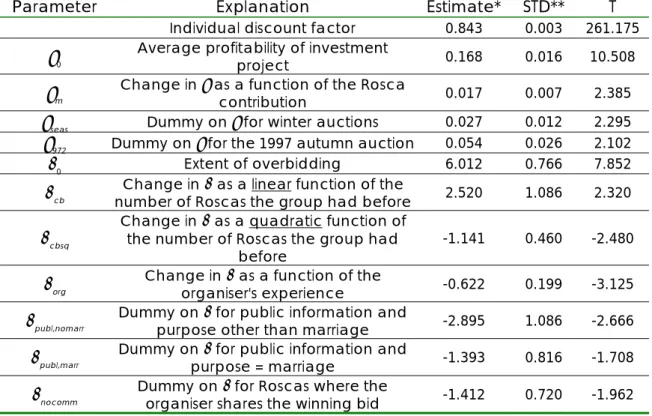Essays on Rotating Savings and Credit Associations
Doctoral Dissertation Department of Economics Ruprecht-Karls Universität Heidelberg Title of the thesis submitted in June 2001:
Three Essays on Rotating Savings and Credit Associations
to my parents
CONTENTS
Contents i
List of Tables iii
List of Figures iii
Acknowledgements iv
0 Introduction and Overview 1
1 Roscas when Participants are Risk Averse 10
1.1 Introduction 11
1.2 Risk Sharing and the Functioning of Bidding Roscas under Private Information 15 1.3 Preferences for Risk Bearing and Preferences for Random and Bidding Roscas 25 1.4 The Rate of Time Preference and the Intertemporal Pattern of Bids 32
1.5 Concluding Remarks 39
1.6 Appendix to Chapter 1 41
1.6.1 Supplement to the Proof of Proposition 1 41
1.6.2 Supplement to the Proof of Proposition 3 43
1.6.3 Proof of Proposition 4 47
2 An Empirical Analysis of Rosca Auctions in a South-Indian Village 50
2.1 Introduction 51
2.2 The Data and some Qualitative Findings 52
2.2.1 The Study Village 52
2.2.2 The Participant Sample 53
2.2.3 The Organiser Sample 60
2.2.4 Stylised Facts about Harvest Bidding Roscas in E 61
2.3 The Model 64
2.4 The Notion of Overbidding in Rosca Auctions and the Gains from Lower Bidding 74
2.5 Structural Estimation of Rosca Auctions 78
2.6 Concluding Remarks 98
2.7 Appendix to Chapter 2 100
3 Summary and Conclusion 104
References 107
LIST OF TABLES
Table 1. The participant sample and selected household characteristics 56
Table 2. Variable-values in Table 1 57
Table 3. Frequency table of participation and active participation in the participant sample 58
Table 4. Tobit analysis of the determinants of the extent of Rosca participation 59
Table 5. The organiser sample: some descriptive statistics 61
Table 6. The organiser sample: frequency table of recorded auction outcomes used for the estimation 86
Table 7. Results for the basic model 88
Table 8. Results for the augmented model 93
Table 9. The organiser sample 100
Table 10. Purpose codes in Table 9 103
LIST OF FIGURES
Figure 1. The intertemporal discount factor, δ, the coefficient of absolute risk aversion, a, and bids in period
one and two for a three-period Rosca with contribution 0.1 34
Figure 2. The rate of time preference, i, and the rate of discount implicit in b1, r1, in a three-period Rosca with contribution 0.1 for different degrees of risk aversion, a. 37
Figure 3. Difference between the rates of discount implicit in the pots’ prices as a function of the coefficient of absolute risk aversion, a, for different values of the rate of time preference, i, in a three-period Rosca
with contribution 0.1 38
ACKNOWLEDGEMENTS
The essays contained in this dissertation were written during my time as a teaching and research assistant in the Department of Development Economics of Heidelberg’s South-Asia Institute.
Without this inspiring environment, I would probably not even have heard of Roscas. It was Susanne van Dillen, now in the Institute’s Department of Geography, who introduced me to Roscas during our joint work on her data on time allocation of village households in south India. Also, without her profound knowledge, her connections and the infrastructure she had created, the field study in Tamil Nadu I undertook in 2001 could never have been as effective as it was. Among my colleagues, I am most indebted to Annegret Steinmetz for extensive discussions on Roscas and other things inside and outside the Institute and during the field study.
In connection with my field study on village Roscas in Tamil Nadu, I would like to thank Mr. B. Joseph Anthony for his services as translator, his wife Mira Perez for her delicious meals, Gnanaprakasam Mathew for his hospitality, and Prof. S. Radhakrishan for his invitation to give a seminar to an audience of local Rosca experts.
Other people who promoted my research at various stages are Siwan Anderson and Patrick Francois, Tim Besley and T.N. Srinivasan. Financial support by the German Verein für Socialpolitik is gratefully acknowledged, which provided funding for a conference presentation of what is now Chapter 1 at the Econometric Society World Congress in 2000. Further, the German Academic Exchange Service (DAAD) sponsored my field study in January and February 2001.
I would like to thank Benny Moldovanu for insightful discussions, a very constructive report on the original draft of this dissertation, and his excellent class on auction theory and mechanism design in the spring term of 1999, where I acquired most of the methodological tools involved in the theoretical parts of this dissertation. Thanks also to Jürgen Eichberger and Eva Terberger-Stoy of
Heidelberg’s Economics Department for joining my doctoral committee and to Oskar Gans for speeding up the formal process involved in becoming a doctor rerum politicarum in Heidelberg.
Finally, I would like to thank two of my teachers, first Hans Ehrbar of the University of Utah, who introduced me to econometrics in 1995/96 and showed me that there is hardly anything more exciting (in the field of economics) than applying sophisticated econometric methodology to real-world data. Secondly, I would like to say that I owe my approach to development economics almost exclusively to Clive Bell of Heidelberg’s South-Asia Institute, who has been much more than a thesis supervisor in the narrow sense during the last five years. It is needless to say that all parts of this manuscript benefited greatly from his comments and suggestions.
0 INTRODUCTION AND OVERVIEW
The rotating savings and credit association (Rosca) is a financial institution which is observed around the world, mainly in developing countries. Bouman (1995) lists about 80 countries in which Roscas are known to operate. Roscas flourish in economic settings where formal financial institutions seem to fail to meet the needs of a large fraction of the population. In general terms, a Rosca can be defined as ‘a voluntary grouping of individuals who agree to contribute financially at each of a set of uniformly-spaced dates towards the creation of a fund, which will then be allotted in accordance with some prearranged principle to each member of the group in turn’ (Calomiris and Rajaraman, 1998). Once a member has received a fund, also called a pot, she is excluded from the allotment of future pots until the Rosca ends.
The timing of the order of allotment follows one of the following two rules. First, the order is determined before or at the first meeting or, second, allotment occurs concurrently at each meeting. Depending on the timing of the order of allotment, several allotment mechanisms have been observed in practice. In the case of a predetermined order, seniority of the participants, negotiation, or a lottery before or at the first meeting (Gugerty, 2000) determine the order. When the order is not predetermined, pots are allotted through concurrent negotiations or a lottery at each meeting (Gugerty, 2000), the decision of the organiser (Handa and Kirton, 1999), or through an auction among those participants who have not yet received a pot. In this latter case, the highest bid wins the pot and the price the winner pays is distributed among the Rosca members or added to future pots. In accordance with the existing literature, Roscas with a lottery and an auction allotment mechanism will be called ‘random Roscas’ and ‘bidding Roscas’, respectively. The present dissertation is primarily concerned with bidding Roscas.
Since the methodological approaches which are taken in this dissertation do not have much in common with the large and growing body of anthropological literature describing Roscas in many parts of the developing world, we do not review this literature here but refer the interested reader to the surveys of Ardener and Burman (1995) and Adams and Fitchett (1992). Instead, we will highlight some particular aspects of this literature, which set the stage for the chapters to follow.
Unfortunately, there is no detailed historic account on the evolution of Roscas anywhere in the world because, traditionally, the Rosca has been an informal institution. It is believed that Roscas started as a very simple financial technology (Geertz, 1962). Today, everywhere in the developing world, Roscas come in different forms and levels of sophistication. Simple Rosca rules are still frequently observed in contemporary studies (see the references above). At the other end of the scale of sophistication are certain bidding Roscas in Cameroon, where there is not only an auction for the pot, but also a secondary market in which the price a winner has to pay for a pot is lent to another member of the Rosca group who offers to pay the highest interest on it (Tchuindjo, 1998). Other case studies from this country report Rosca arrangements which have become so flexible that neither the number of participants nor the contribution in each round is fixed in advance (Tankou and Adams, 1995).
In India, Roscas seem to have emerged in the southern part of the subcontinent. Today they are known throughout the country as ‘chit funds’, or ‘chits’ in short. ‘Chitty’ is a Tamil word meaning written piece of paper or palm leaf. In fact, traditionally, there is one written piece of paper for each participant, which serves as a lot to determine the order of receipt.
Radhakrishnan et al. (1975) cite evidence that chit funds had been in existence in the form of grain chits well before the introduction of money. Such Roscas in kind still exist, even in comparatively well-developed villages as the one studied in Chapter 2. On the other hand,
India probably also has the most professionally organised formal Roscas in the world. In major cities, large chit fund companies run as many as 10,000 auction Roscas simultaneously.
These are regulated, just as banks are regulated in the western world. The Chit Fund Act obliges every organiser of a Rosca to register with a government authority, to deposit some reserves to compensate participants in the case of bankruptcy, and to end auctions prematurely at specified bid ceilings (Radhakrishnan, 1977). In consequence, Roscas which are not registered with the government are illegal. In rural settings like the village studied in Chapter 2, however, Roscas are almost never registered. Perhaps this explains why informal Roscas in India have received so little attention from researchers compared to informal Roscas in African countries. A notable recent exception, however, is Calomiris and Rajaraman (1998).
For less developed countries, little is known about general participation rates in Roscas because, first, Roscas are mostly operated on an informal basis and, in this case, do not appear in any financial statistics, and, second, in such countries, large-scale sample surveys are typically rare. Even in India, where there is the exemplary National Sample Survey Organisation (NSSO) and Roscas play an important role, the NSSO does not canvas participation in Roscas. For some African countries, somewhat rough estimates of Rosca participation are reported by anthropological authors and range between 45 and 95% of households. Gugerty (2000) provides a good, up-to-date survey of this literature. The only developed country for which substantial Rosca participation is documented is Taiwan.
Levenson and Besley (1996) report that, in 1991, about 80% of the households participated in at least one Rosca. This does not mean, however, that Roscas are completely unheard of in western countries. With the international migration of labour, Roscas seem to have spread to any place where people from areas where Roscas traditionally play an important role have settled. Ardener and Burman (1995) report Roscas among employees of the International
Monetary Fund headquarters in Washington D. C. as well as among Asian immigrants in London.
Little theoretical work has been done on Roscas. This is astounding given the world- wide prevalence of this institution and the enormous attention devoted to other contractual arrangements encountered in the developing world, like sharecropping contracts and interlinked transactions. To my knowledge, there are only four papers which use advanced analytical tools (Besley et al. 1993, 1994; Kovsted and Lyk-Jensen, 1999; Kuo, 1993), and three recent applied papers, which involve simple models (Aliber, 2000; Anderson and Balland, 1999; Gugerty, 2000). None of these three latter-mentioned papers involves bidding Roscas, which are the subject of this dissertation. Instead, the emphasis is on the analysis of primary data on Rosca participation which these authors have collected. In contrast, the papers by Besley et al. and Kovsted and Lyk-Jensen deal with both random and bidding Roscas. It will now be argued that the settings in which these authors analyse bidding Roscas are found rarely, if at all, in the real world.
Besley, Coate and Loury (1993) consider individuals who have an identical, deterministic income stream and no access to outside credit. Individual utility is concave in current consumption and the funds from a Rosca are used to purchase an indivisible durable good which facilitates extra utility in each period after its purchase. The costs of the durable require saving for more than one period. Individuals may differ in the utility they derive from the durable, but information on this is public. The authors find that identical individuals prefer a lottery allotment mechanism, while the bidding allotment mechanism is preferred if the valuation for the durable differs sufficiently among the participants. In their framework, the auctions in the course of a bidding Rosca serve to identify the bidder with the highest valuation for the durable. Since all information is public, the auction does not involve any strategic element. The particular auction protocol which Besley et al. design requires that, in a
n-person bidding Rosca, all n - 1 auctions take place at the beginning of the Rosca and ensures that all participants obtain the same level of utility from joining the Rosca. Its singular drawback, as Calomiris and Rajaraman (1998) point out, is that it is not reported at all in the empirical literature. In my view, the major contribution of Besley et al.'s 1993 paper is to the economics of indivisible goods, which had not received much attention in neoclassical economics before, and only secondly to the economics of Roscas, as the title of their paper would suggest.
In a companion paper, Besley et al. (1994) use the same indivisible-good framework and compare allocations which result from participation in random and bidding Roscas with allocations which are feasible when individuals borrow and lend each other money. In this paper, they restrict themselves to identical individuals who thus have identical valuations of the indivisible good. The authors show that allocations with borrowing and lending are always superior to allocations with a bidding Rosca, but that the element of chance inherent in a random Rosca may yield allocations which are superior to a credit market. The result on the efficiency of bidding Roscas is scarcly surprising since, first, the payoffs of a bidding Rosca are less flexible than those of direct borrowing and lending and, second, there is neither heterogeneity nor private information on the individuals' valuation of the durable good.
An approach which is related to Besley et al. (1993) is taken by Kovsted and Lyk- Jensen (1999), who also assume that all participants have an identical, deterministic income stream. Instead of desiring to purchase a durable consumption good, however, their participants have prospective investment projects which, once purchased, yield a certain revenue but whose fixed costs exceed an individual’s period income. Costly credit from outside the Rosca is available and all participants’ preferences are identical. Before the beginning of the Rosca, each participant privately observes the revenue of the investment project to which he has access. Assuming that nature draws this revenue from the same
distribution for all participants, the authors apply the symmetric, independent private value (SIPV) approach to analyse the auctions of a bidding Rosca in such an environment. In contrast to Besley et al., the strategic analysis of Rosca auctions under Kovsted and Lyk- Jensen’s assumptions is not trivial because the investment project’s revenue is each bidder’s private information. The goal of their paper is to identify criteria which determine whether allocations with a random or a bidding Rosca are preferred ex ante, that is, before each participant observes his revenue. On the one hand, a random Rosca has the advantage of allocating the full pot to each winner, while an auction’s winner in a bidding Rosca has to incur costly debt to finance the price he has to pay for the pot. On the other hand, in a bidding Rosca, each auction identifies the bidder with the highest revenue, while, with a random Rosca, less profitable investment projects may be implemented first. In this connection, the authors find that, when outside credit is not too costly, or when the distribution of revenues is sufficiently widely dispersed, a bidding Rosca is preferred to a random Rosca.
It should be remarked that, to solve for the bidding equilibrium of a Rosca, Kovsted and Lyk-Jensen consider only first-price sealed bid auctions in which only the winner’s bid is revealed. To my knowledge, however, such auctions are not reported in any of the empirical literature. Consider, therefore, the frequently-practised oral ascending bid auction. In this case, Kovsted and Lyk-Jensen's sequential bidding equilibrium breaks down, because, after each auction, the losing bidders, who remain for the next auction, have learned something about the revenue of their competitors. For Kovsted and Lyk-Jensen’s equilibrium analysis it is essential, however, that, from each bidder’s perspective, all other bidders be identical.
The approaches to bidding Roscas taken by Besley et al. and Kovsted and Lyk-Jensen are deterministic in the sense that all payoffs which occur during the course of the Rosca can be calculated before the beginning of the first auction because each participant’s income stream as well as his preferences (Besley et al.) and his revenue of the investment project
(Kovsted and Lyk-Jensen) remain constant from the beginning till the end of the Rosca. As a consequence, all auctions can be staged at the beginning of the Rosca and need not take place concurrently with allotment, as reported by almost all empirical studies.
In a stochastic Rosca model, in contrast, random variables which are not yet realised at the beginning of the Rosca determine the outcome of each auction. The first stochastic Rosca model is due to Kuo (1993), who analyses bidding Roscas when individuals are risk neutral and use Rosca funds for consumption. He assumes that individual future consumption is discounted with a random discount rate, whereby each individual is assigned a new discount rate before each auction. Assuming that the bidders’ discount rates are independently drawn from a common distribution before each auction and privately observed, the author applies the SIPV framework to derive bidding equilibria. In his model, the advantage of joining a Rosca arises from the possibility to consume more in a period in which one has a comparatively high marginal utility of current consumption. In this context, the auction is a mechanism to overcome information asymmetries. To my knowledge, however, there is no empirical study which reports that, in an environment without risk aversion and income uncertainty, Rosca funds are used for current consumption. Instead, it appears from the empirical evidence that Rosca funds are invariably used for either some lumpy expenditure, be it a consumer durable, an investment project or a marriage festival, or for consumption in order to smooth an income shock (Calomiris and Rajaraman, 1998).
Based on the discussion in the preceding paragraphs, we claim that the theory papers by Besley et al. (1993, 1994), Kovsted and Lyk-Jensen (1999) and Kuo (1993) are irrelevant as "applied" theory because they contain essential elements that do not even closely correspond to the real world. The aim of this dissertation is to develop models of bidding Roscas with more realistic assumptions. There is much empirical evidence in favour of the choice of stochastic Rosca models as the basis for analysis. First, as Calomiris and Rajaraman
(1998) note, all empirical studies on bidding Roscas except one report auctions which take place concurrently with allotment rather than at the beginning of the Rosca. Second, deterministic models are not compatible with fluctuating winning bids, which are observed in practice. That is to say, a higher winning bid is observed in the t-th than in the (t – 1)-th auction. The model of Kovsted and Lyk-Jensen, however, yields the result that, during the course of the Rosca, the winning bid decreases from auction to auction.
The first chapter elaborates on the idea advocated by Calomiris and Rajaraman that bidding Roscas can serve as insurance when the participants face income shocks which are not perfectly correlated over individuals. In the first chapter, we analyse a bidding Rosca with risk averse participants who face identically and independently distributed, privately observed incomes which are drawn anew by nature before each meeting. In the context of the existing literature, this approach has most in common with Kuo’s. As in his paper, Rosca funds are used for consumption and the SIPV framework is applied to analyse Rosca auctions. Our approach differs substantially from his, however, in that we consider income shocks instead of taste shocks and in that our participants are risk averse whereas his are risk neutral. Moreover, while he restricts attention to first-price sealed bid Rosca auctions, we focus on oral ascending bid Rosca auctions, which are empirically more relevant and have some particular properties which make them substantially different from standard SIPV oral ascending bid auctions.
In the light of the first chapter, it would have been most desirable to collect Rosca data in a setting where participation in bidding Roscas is motivated by the intention to insure against income shocks. Calomiris and Rajaraman (1998) describe such a Rosca among casual labourers in an Indian city. Since the time frame for the field study was limited, however, and since I had access to excellent data of a longitudinal study of a south-Indian village (van Dillen, forthcoming) including a survey on Rosca activity, I decided to investigate bidding Roscas in the said village – although it was quite clear that, within this setting, the insurance
aspect of Roscas plays only a minor role. Thanks to the contacts, trust and infrastructure established by van Dillen, I managed to collect an extensive dataset on Rosca auctions.
Comparing the auction outcomes of informal Roscas is particularly difficult, however, because, typically, each Rosca is different from any other, be it with respect to the number of participants, the amount of the contribution, or the way in which the Rosca organiser is remunerated. Therefore, some structure is needed to make the auction outcomes in the dataset comparable. To this end, in Chapter 2, we develop a stochastic Rosca model which reflects the salient features of Rosca auctions in the study village and estimate the resulting structural model by maximum likelihood. To my knowledge, this is the first empirical analysis of Rosca auctions.
To summarise, the central idea underlying both chapters is the one of a stochastic approach to bidding Roscas in a private information environment. In accordance with much of the empirical literature, this is motivated by the persuasion that, so far, economists have unfairly neglected the potential which the auction allocation mechanism offers to overcome information asymmetries and to respond to shocks or opportunities which cannot be observed when a Rosca begins.
1 ROSCAS WHEN PARTICIPANTS ARE RISK AVERSE
Abstract
Recent theoretical research on rotating savings and credit associations (Roscas) suggests that identical individuals prefer a random to a bidding Rosca when participants save for a lumpy durable or an investment good. Here, in contrast, under the assumption that Rosca funds are used for consumption, that participants are risk averse, and that their incomes are stochastic, independent and privately observed, it is shown that a random Rosca is not advantageous, while a bidding Rosca is so if temporal risk aversion is less pronounced than static risk aversion. The payoff scheme of a bidding Rosca helps to mitigate the problem of information asymmetries. In bidding Roscas, the intertemporal pattern of observed bids depends on impatience and risk aversion in a non-trivial way.
1.1 Introduction
It is widely recognised that in low-income countries risk plays a crucial role in everyday life.
In the agricultural sector, there is uncertainty about rainfall and crop damage, in the cities, casual labourers face employment uncertainty. In both sectors, the prevalence of infectious diseases makes labourers’ ability to generate income uncertain. At the same time, poor public infrastructure, illiteracy and an inefficient legal system impose limits on the functioning of formal market institutions that may insure such risks (see Besley, 1995). While some governments try to mitigate aggregate shocks, e.g. by accumulating and releasing food stocks, the absence of formal health and unemployment insurance often leaves individuals alone when they are affected by idiosyncratic shocks. Because of this lack of formal insurance markets, however, numerous nonmarket risk-sharing institutions are observed. The basic idea underlying all these institutions is that, if shocks are not perfectly correlated across individuals, transfers contingent on each individual’s shock improve each individual’s situation, at least from an ex ante perspective.
The analysis of such institutions has a long history in development economics dating back to Cheung’s (1968) contribution on risk sharing in sharecropping contracts. More recently, economists’ interest in this field has grown rapidly. In an empirical investigation, Udry (1990) finds that informal credit in rural Nigeria serves as insurance against idiosyncratic risks. In a theoretical paper, Coate and Ravallion (1993) characterise optimal risk sharing between two households when contractual claims cannot be enforced. In both studies, each household head observes not only his own but also his contract partner’s income. This assumption may be reasonable in the context of rural villages, where information flows freely. In urban settings, where income is generated mostly outside the residential neighbourhood (or slum), individuals may only observe their own incomes.
Eswaran and Kotwal (1989) allow private information on incomes but exclude any enforcement problems. They find that, in a two-period world, a market for consumption credit facilitates higher investment than autarky because individuals can smooth their consumption streams by lending and borrowing instead of putting money aside unproductively.
In a multi-period world, the analysis of risk sharing with private information becomes rather complicated. Green (1987), Phelan and Townsend (1990), and Atkeson and Lucas (1992) consider a principal and one or many risk averse agents and characterise incentive- compatible allocations. ‘Incentive-compatible’ in this context means that, for each agent, reporting the realisation of his income truthfully, constitutes a Nash equilibrium. In all of these papers, there is neither individual borrowing nor saving and aggregate consumption does not need to equal aggregate income. In Wang (1995), in contrast, there is no principal and an aggregate budget-balancing constraint is imposed. He analyses the constrained efficient, incentive-compatible insurance contract among two infinitely lived, ex-ante identical agents when incomes are privately observed and enforcement problems are absent.
There are very few papers addressing the performance of existing nonmarket institutions in developing countries when incomes are privately observed. The reason for this is likely that the mainstream of micro-development economics has focused on the theory of contracts and institutions in the agricultural sector and, as argued above, within a village, information on individual states is often public knowledge. An exception is Udry (1994), who also considers idiosyncratic income shocks which are privately observed.
In the empirical literature on Roscas, it has been argued for a long time that, when participants are exposed to risk, Roscas can serve as a risk-sharing mechanism. In the context of Roscas without a bidding allocation mechanism, this has first been suggested by Ardener (1964), who observed that, in Roscas with a predetermined order of receipt of the pot, the order may be changed in favour of a participant who suffers some unforeseen liquidity crisis
in the course of the Rosca. Of course, this mechanism only works when the said liquidity crisis is observed by all participants or at least by the organiser. Platteau (1997) interprets bidding Roscas as an intertemporal redistribution mechanism, where “the group member who accepts the biggest deduction and who is presumably the most hard-pressed by emergency needs, receives what remains of the common fund after the agreed deduction is effected” (p.
785).
Calomiris and Rajaraman (1998) find evidence that the timing and the extent of such emergency needs are not known to the participants when they join a Rosca and interpret this as evidence against the deterministic Rosca models of Besley et al. (1993, 1994). Calomiris and Rajaraman argue that, except for one case1, all of the empirical literature reports Rosca arrangements where bidding is concurrent with the allocation of pots. In the approaches taken by Besley et al. (1993) and Kovsted and Lyk-Jensen (1999), however, the auctions for all future pots can be staged at the beginning of the Rosca. Another striking difference lies in the course of the winning bid from period to period. For an actual Rosca in an Indian city, Calomiris and Rajaraman (1998) find that winning bids do not decrease steadily from auction to auction, which contradicts the predictions of the models of Besley et al. (1993) and Kovsted and Lyk-Jensen (1999). Calomiris and Rajaraman conclude that, at least for their particular Rosca, deterministic models do not capture the essential features. Instead, they stress the role of Roscas as an insurance mechanism by allocating each period’s pot to the bidder who has suffered the most severe shock.
Of course, Roscas cannot effectively insure against aggregate shocks when participants belong to an economically and socially homogenous group like small farmers in a village whose harvests depend on the weather to a large extent. But even here, as Townsend’s
1 This is Campbell and Ahn (1962) for Korea.
(1994) results suggest, a variety of mechanisms appear to be at work in providing substantial insurance against idiosyncratic risks like illness or the death of farm animals. We do not claim that Roscas never play a role for the accumulation of funds to finance lumpy goods. There is, however, a startling imbalance between the number of empirical studies which stress the risk- sharing aspect of Roscas and the focus of theoretical papers on Roscas, which have completely neglected this aspect so far. It is this imbalance which motivates this essay.
In this essay, we analyse how a bidding Rosca functions under the following assumptions, which are set out and discussed in detail in section 1.2. First, participants are risk averse and use funds from the Rosca entirely for consumption, each participant’s income being stochastic. Second, participants cannot observe other participants’ incomes, but all share the same beliefs about the distribution from which the incomes are drawn. By assuming such a private information environment, the analysis focuses on urban Roscas among homogenous participants who do not observe each other’s incomes, e. g. hawkers and shoeshine boys (see Nayar, 1983, and Calomiris and Rajaraman, 1998, for examples from India). Third, we employ the invariable assumption in the literature on risk sharing (see, among many others, Coate and Ravallion, 1993, and Wang, 1995) that transfers of income across periods are possible neither through storage nor through borrowing and lending.
Fourth, the analysis of this chapter is restricted to the case of participation in one single bidding Rosca. Section 1.3 investigates what restrictions on preferences are required to induce participation in either a random or a bidding Rosca. Section 1.4 looks at the intertemporal pattern of observed winning bids. Section 1.5 summarises the findings and offers conclusions.
1.2 Risk Sharing and the Functioning of Bidding Roscas under Private Information
It is well known that in the absence of borrowing and savings opportunities, the optimal risk- sharing contract among n ex ante identical individuals involves pooling all individual incomes and allocating one n’th thereof to each individual in each period. Such an arrangement, however, requires that, in any period, each individual’s income is public knowledge. While this is a reasonable assumption for residents of a small rural village who generate their incomes within that village, it is less persuasive in an urban setting, where the income of a casual labourer may be exclusively his private knowledge. In such cases, the arrangement just outlined collapses, because there is an incentive to underreport one’s income and thus contribute less to the income pool. Thus a risk-sharing mechanism under such informational constraints must give individuals an incentive to report their incomes truthfully. Specifically, in a two-individual-two-period context, such an incentive can be generated by intertemporal trade, compensating the individual who is a net payer in the first period with a positive net transfer in the second. If the world ends after two periods, then, in the second period, no further intertemporal trade can take place.
Exactly these features can be found in a two-participant-two-period bidding Rosca:
before the first period, the two participants A and B make an arrangement whereby each pays a stipulated amount m into a pot in each period. In the first period, the participants bid for pot one. Assuming that half the price paid for this pot, b say, is allocated to each participant, one would expect the participant with the higher current need for funds, A say, to win this auction.
In this context, ‘higher need’ is equivalent to ‘lower first-period income’. Consequently, in the first period, A receives a net transfer of m – b/2 from B. According to the rules of the Rosca, however, B receives the pot and thus a net transfer of m from A in the second period.
This latter transfer can be viewed as the ‘price’ A has to pay for the transfer she received from B in the first period.
To set out the analytical framework, assume that each of the two participants2 evaluates consumption levels in periods one and two ci1 and ci2, respectively, with a bivariate von-Neuman-Morgenstern utility function, u(ci1, ci2), which is strictly increasing and concave in each argument, and that, in period t, her income yit
3 is drawn from a distribution characterised by the smooth distribution function F on the domain I = [yl, yu]. All Yit, i, t = 1, 2 are assumed to be independently and identically distributed according to F. Support for this assumption comes from the fact that Rosca participants typically belong to the same social and professional group (see, e. g., Bouman, 1979). It is further assumed that participants have access to neither credit nor savings opportunities outside the Rosca.
Although the absence of savings opportunities in particular appears to be a very restrictive assumption, it is a fact that in many urban settings where Roscas are observed it may be dangerous or even impossible to store money. Also, as Anderson and Balland (1999) argue, a Rosca may offer a wife the opportunity to withdraw money from her husband's sphere, who may have different, likely more short-sighted, ideas about how to use the money. In this section it is further assumed that each individual participates in only one Rosca and that the contribution to the Rosca each member makes in each period, m say, has been agreed upon beforehand and can be considered fixed.
To avoid technical complications, we assume that participants can always pay their
2 For ease of exposition, I restrict attention to two-period Roscas.
3 Throughout this dissertation, random variables are denoted by capital letters, while lower case letters denote realisations.
contribution m, even if they are hit by the most severe income shock possible. Formally, define cmin≡ yl – m. We require that cmin≥ 0 and that u x x( ,1 2) be strictly bounded from below on the domain Du≡ {( ,x x1 2):x1 ≥cmin,x2 ≥cmin}.
Any problems of enforceability of contributions to the Rosca by members who have received a pot earlier, and are thus left with only obligations, are neglected. This can be justified by the fact that defaulting on contributions results in exclusion from future Roscas and by assuming that the disutility therefrom is prohibitively high.4 Another important empirical feature, the remuneration of the Rosca organiser, is also excluded from this analysis.
In the literature, a variety of arrangements have been observed when it comes to the auctioning of the pot. There are various rules determining how the price for a period’s pot is used. The most important issue is whether the said price is added to future pots (as in Calomiris and Rajaraman, 1998), or distributed at once, and if the latter, either among all or only among the active participants (as in Radakrishnan et al., 1975).5 Throughout this dissertation, we will focus on the latter system, where the price is distributed instantaneously.
In this chapter we will, moreover, assume that the winning bid is distributed among all Rosca participants.
We will confine our analysis to oral ascending bid (OA) auctions, which are the predominantly encountered auction type in actual bidding Roscas. In an OA-Rosca auction,
4 There is sufficient empirical evidence in support of this assumption. See, among others, Calomiris and Rajaraman (1998).
5 In accordance with the literature, those participants who have not yet received a pot are referred to as 'active'.
the active participants meet and submit successive oral bids until only one bidder, the winner, remains. As in the analysis of standard auctions with symmetric, independent private value (SIPV) bidders,6 one may model such an OA-Rosca auction as a button Rosca auction where each of the two bidders presses a button in front of her as the standing bid continuously increases. The auction is over once one of the two bidders, i say, releases her button. In this case, the other bidder, j say, receives the pot at a price equal to the standing bid at the moment i dropped out. For the derivation of bidding equilibria in a button Rosca auction, it is useful to consider a second-price sealed bid (SPS) Rosca auction. In this auction, both bidders submit their bids in sealed envelopes. The highest bid wins and the winner pays a price equal to the second highest bid submitted. Although this type of auction is not reported in any of the Rosca literature, in the present case, its equilibrium is also an equilibrium in the button Rosca auction. In the button Rosca auction, each bidder’s problem is to decide when to release her button. Suppose that each bidder releases her button at a standing bid equal to her bid in the SPS-Rosca auction. If both bidders follow this rule, the payoffs to both of them are equal in the SPS and the button Rosca auction. Moreover, in a button Rosca auction with two bidders, the information set of each bidder during the auction is the same as the information set of a bidder in a SPS-Rosca auction because, during the course of the button auction, each bidder
6 In a standard SIPV bidder auction, there is one seller who owns a single, indivisible item and K buyers. Each bidder knows K and his own valuation (or value, in short) for the item, which is the maximum amount he would be willing to pay for the item, but none of the other bidders’ values. The values are identically and independently distributed (see Matthews, 1990). It is further assumed that the seller cannot set a minimum price.
only observes whether the auction is still going on or not.7 In the language of game theory, the reduced normal form games corresponding to the second-price sealed bid and the oral ascending bid Rosca auction are identical. Thus they are strategically equivalent, which implies that the equilibrium of the SPS-Rosca auction is also an equilibrium of the OA-Rosca auction.8
With this in hand, we can now embark on the strategic analysis of OA-Rosca auctions.
As a first step, it is useful to introduce the concept of the maximum willingness to pay for period one’s pot. After a participant, i say, has observed her first-period income, y say, and if she receives pot one at price b, her consumption in the first period is given by y - m + (2m - b + b/2) = y + m – b/2, where y - m is her first-period income minus her contribution to the Rosca and (2m – b + b/2) is the pot she receives minus the price b, plus the half of this price that is redistributed to her according to the rules of the Rosca. In this case, i’s second-period consumption is y2 – m, where y2 denotes the realisation of her second-period income. Accordingly, her expected utility after observing y is uwin(b, y)
≡ ~(u y+ −m b/ ,2 Y−m), where Y denotes the random variable corresponding to y2 and u (~ ⋅, X) ≡ EX[u(⋅, X)] = u x dF x
y y
l
u ( , )⋅ ( )
I
. If, on the other hand, the other participant receives pot one at price b, i’s expected utility is given by ulose(b, y) ≡ ~(u y− +m b/ ,2Y+m).
7 A discussion of button Rosca auctions with more than two bidders can be found in section 2.3.
8 This reasoning is similar to the argument which establishes strategic equivalence of first- price sealed bid and Dutch auctions for standard SIPV bidder auctions. See, e.g., Matthews, 1990.
Now consider an OA-Rosca auction where the standing bid b is raised subsequently.
At low levels of b, a bidder with first-period income y prefers winning pot one to losing it, formally uwin(b, y) > ulose(b, y) for sufficiently small b. Given the definition of u(⋅,⋅), however, the said bidder’s preference over winning or losing pot one is reversed at sufficiently high levels of the standing bid, formally uwin(b, y) < ulose(b, y) for sufficiently large b. We define the maximum willingness to pay for pot one, b0 say, as that level of the standing bid at which a bidder is indifferent between winning and losing pot one. Formally, b0(y) is the value of b that satisfies
( 1 ) u y~( − +m b/ ,2Y+m)=u y~( + −m b/ ,2 Y−m).
It is now argued that b0 corresponds to a bidder’s value in a standard (not a Rosca) auction with SIPV bidders. In such auctions, by definition, a bidder is indifferent between winning and not winning the item auctioned when she has to pay a price equal to her true value. This definition applies to b0(y) in the present case; for by ( 1 ), a bidder with first- period income y is indifferent between receiving pot one and not receiving it at a level of the standing bid equal to b0(y).
In what follows, it will be assumed that the participant with the more severe income shock in period one has a higher maximum willingness to pay for pot one:
Assumption 1: b0 is strictly decreasing in period-one income, formally ( 2 ) db y
dy
0( )
= 2
~ ( ( ) / , ) ~ ( ( ) / , )
~ ( ( ) / , ) ~ ( ( ) / , )
u y m b y Y m u y m b y Y m
u y m b y Y m u y m b y Y m
1
0
1
0
1
0
1
0
2 2
2 2
+ − − − − + +
+ − − + − + + < 0 for all y.
We now derive a symmetric Bayes-Nash bidding equilibrium of a SPS-Rosca auction, which is also a symmetric equilibrium of an OA-Rosca auction, as has been argued above. Towards this end, assume that i conjectures that j determines her bid bj according to a smooth, strictly
decreasing function b(yj), where yj denotes j’s first-period income. Because of the private information assumption, for i, j’s first-period income is a random variable distributed according to F. Therefore, from i’s perspective, the probability of losing the auction conditional on bidding bi is P(bi< b(Yj)) = P(b-1(bi) > Yj) = F(b-1(bi)), where the events bi< b(Yj) and b-1(bi) > Yj are identical by virtue of the assumption that b(⋅) is a strictly decreasing function. The probability that i loses is, by definition, 1 - P(bi< b(Yj))
= 1 - F(b-1(bi)).
If i loses the auction, her expected utility conditional on her first-period income yi and her bid bi is ~(u yi − +m bi/ ,2 Y+m). If, on the other hand, i wins the auction, her expected utility conditional on yi and bi is E u y[~( i+ −m b Y( ) / ,j 2 Y−m Y)| j >b−1( )]bi . Consequently, i’s interim expected utility9 as a function of her bid bi is given by
E[U(bi)| yi] ≡ ~(u yi − +m bi / ,2Y+m)F(b-1(bi)) ( 3 )
+ E u y[~( i+ −m b Y( ) / ,j 2 Y−m Y)| j >b−1( )]bi (1 - F(b-1(bi))), and i’s task is to maximise E[U(bi)| yi] by choice of bi. The corresponding first-order condition reads
∂
∂ = − + + −
E U b y
bi i u y m b Y m F b b
i
i i i
[ ( )| ] 1~ / , ( ( ))
2 1
1
26
1( 4 )
+ ~ / , ~ / , ( ( ))
( ( ))
u y m b Y m u y m b Y m f b b
b b b
i i i i
i i
− + + − + − −
′
−
2 2 −
1
1 6 1 6
12 7
= 0.
9 In accordance with the literature on SIPV auctions, at the interim stage, a bidder has observed her type (in the present case determined by yi) but not yet submitted her bid.
The Bayes-Nash equilibrium bidding strategy, bs(⋅) say, is obtained by substituting b(yi) for bi
in the RHS of ( 4 ), where the subscript s indicates that bs(⋅) characterises an equilibrium of a SPS- and thus of an OA-Rosca auction.
Proposition 1: Consider a two-participant-two-period bidding Rosca with an oral ascending bid auction, in which assumption 1 holds. Then
(i) in a symmetric Bayes-Nash equilibrium, each bidder quits the auction at a standing bid equal to bs(y), where y is a bidder’s privately observed first-period income and
( 5 ) bs´(y) = 2 2 2
1 2 f y
F y
u y m b y Y m u y m b y Y m
u y m b y Y m
s s
s
( ) ( )
~( ( ) / , ) ~( ( ) / , )
~ ( ( ) / , )
+ − − − − + +
− + +
! "
$#
,( 6 ) bs(yl) = b0(yl);
(ii) in such an equilibrium, bidders overbid relative to their maximum willingness to pay, i.e.
bs(y) > b0(y) for all y > yl;
(iii) bids are strictly decreasing in income, i.e. bs´(y) < 0 for all y.
Proof:
(i) Necessity follows from ( 4 ).
(ii) By applying L’Hôpital’s rule to the RHS of ( 5 ) in view of the fact that yl constitutes a singularity for the differential equation ( 5 ), we obtain
( 7 ) bs´(yl) = 2 2 2
2 2 2
1
0 0
1
0
1
0
~ ( ( ) / , ) ~( ( ) / , )
~ ( ( ) / , ) ~ ( ( ) / , )
u y m b y Y m u y m b y Y m
u y m b y Y m u y m b y Y m
l l l l
l l l l
+ − − − − + +
+ − − + − + + ,
where, according to ( 6 ), b0(yl) has been substituted for bs(yl). Comparing ( 2 ) with ( 7 ), it follows that
( 8 ) 0 > bs´(yl) > b0´(yl).
Combining ( 8 ) with ( 6 ), we obtain
Lemma 1: There exists an ε> 0 such that bs(y) > b0(y) for all yl< y ≤ yl + ε. Now assume that
( 9 ) bs(y0) = b0(y0) for some y0 > yl. By ( 1 ) and ( 5 ), ( 9 ) implies that ( 10 ) bs´(y0) = 0.
By assumption 1, however, ( 11 ) b0´(y0) < 0.
Hence, for any y0> yl, bs intersects b0 from below, which contradicts Lemma 1. Thus, ( 12 ) bs and b0 cannot intersect for any y > yl.
Moreover, by combining ( 10 ) and ( 11 ), we find that ( 9 ) implies that bs´(y0) > b0´(y0) and hence
( 13 ) bs cannot touch b0 for any y > yl.
Combining ( 12 ) and ( 13 ) with Lemma 1 gives the desired result.
(iii) Since, by virtue of (ii), bs(y) > b0(y) for all y > yl, it follows from ( 1 ) and the fact that u is strictly increasing in its first argument that the RHS of ( 5 ) is negative. Together with the first inequality in ( 8 ), this gives the desired result.
QED
